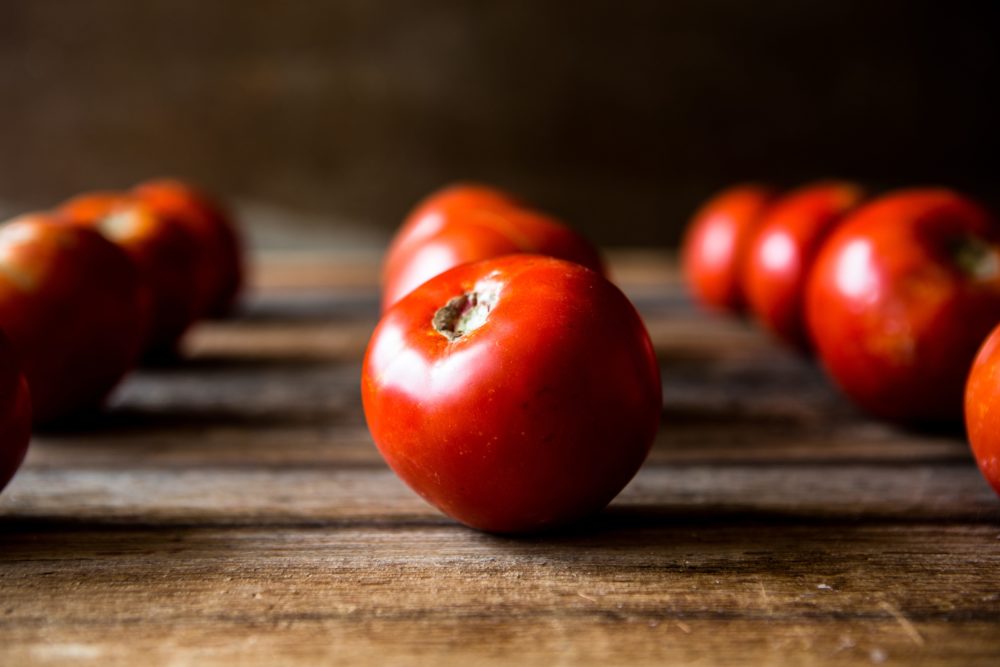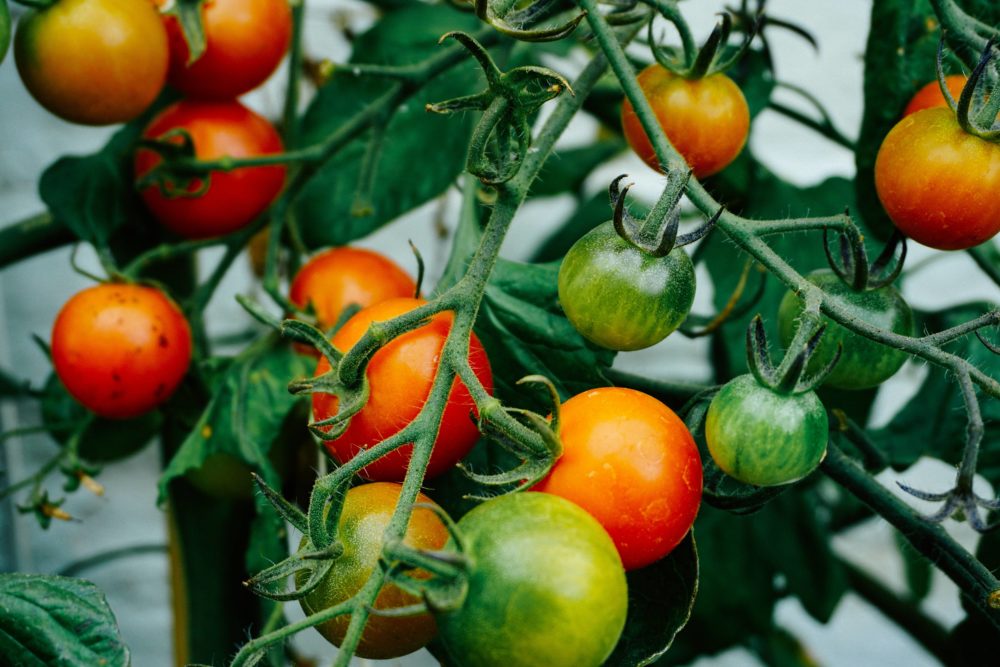The tomato plant is the most common vegetable (fruit, technically) plant in the household garden. Almost everyone has tried growing tomatoes at some point in his or her lifetime, and no wonder!
They are forgiving plants that can be grown in almost every zone, producing abundant fruits to share with friends, neighbors, and family. We all know that the taste of a tomato picked ripe from the garden cannot be compared to the bland, mealy, pre-picked tomato from the grocery store. The number of varieties that can be grown is seemingly endless, producing fruits that vary in size, color, texture, and flavor.
How does one choose which varieties to grow? And how do we deal with those pesky diseases and pests that can plague our precious plants? And what do we do when we have more tomatoes than we can possibly consume or give away? Join me as we explore the world of growing tomatoes, including varieties, disease and pest control, and preservation.
Benefits of Growing Tomatoes
There is nothing like the taste of a cherry tomato straight from the day on a hot summer day. Many of the nutrients that make tomatoes nutritional powerhouses are fat soluble, meaning they can only be absorbed by the body if they are consumed with a healthy fat. Eat your tomatoes sprinkled with olive oil or layered with homemade fresh mozzarella. Tomatoes are high in lycopene, vitamin A, and C, as well as a number of phytonutrients, depending on their color.
Various Types of Tomato Plants
Indeterminate Tomatoes
Indeterminate tomatoes are the gifts that keep on giving. If you have space (and the trellising), indeterminate tomatoes can provide continuous production from the beginning of the warm season up until the first frost.
These tomato plants grow as a vine and require trellising and support in order to remain a healthy plant. They will also require some pruning. As the plant moves its energy down the vine to new foliage and tomato clusters, it cuts off nutrients and water to the branches at the base. Trimming off the brown, dry branches can reduce the risk of fungus and disease for your plant. Cutting off “suckers” from tomato plants is not necessary, and often sacrifices potential tomato clusters.
Determinate Tomatoes
Determinate tomato plants are often referred to as bush plants. These plants grow to a certain size, produce for only a few weeks, and then die back. This type of plant is ideal for gardeners with small spaces or minimal trellising. To ensure a continuous supply of tomatoes throughout out the season, successive plantings will have to be made every few weeks.
Hybrid Tomatoes
A hybrid plant has been cross-pollinated with a different variety within the same plant species. Hybridization is done over years, by cross-pollinating parent plants that contain desired characteristics. Hybrid seeds cannot be saved – their offspring will not share the traits of their parent plant.
Non-GMO Tomatoes
Genetically modified plants have been genetically altered in an unnatural way, often by inserting genes from other species into the DNA of the plant. GMO tomatoes were introduced in the 1990’s but were not successful. Genetically modified tomatoes are not widespread.
Heirloom/Open-Pollinated
Open-pollinated seeds are pollinated by natural means such as insects and wind. These plants create seeds that are true to the parent plants’ characteristics. These seeds can be saved and replanted, creating seeds that have adapted to your unique microclimate. The distinction of heirloom is typically reserved for open-pollinated varieties that have been passed down for 50 years or longer.
I have not listed specific varieties because these will vary from region to region. I do encourage you to branch out from the traditional red, round tomato. Tomatoes come in various sizes – cherry, grape, oval and round. They also come in various colors – yellow, pink, orange, red, purple, green and even striped. Remember, varied color in our produce means varied nutrients– something we all could use. Differing varieties will also have differing textures. Paste tomatoes are great for makes sauces, acidic tomatoes are great for water bath canning, and nothing beats a cherry tomato for pico de gallo.
Growing Tomatoes: Caring for Your Plants
One of my many mottos in the world of farming and gardening is: A healthy plant can fend for itself. Given this, there are things that we can do to help our plants remain healthy and stress-free.
Start with Healthy Soil
Balanced soil that contains humus and is regularly layered with compost and mulch will be teeming with beneficial insects, fungus, algae, and microorganisms. The organisms will create a hospitable environment for your plants to thrive, making nutrients available without the need for artificial fertilizers. Feed the microbiology in your soil, and they will feed your plants.
Mulch the Soil beneath your Tomato Plants
Heavy rains can cause the soil to splash upon the foliage of your plants, leaving a chance for fungus and bacteria to thrive, especially in humid climates. Mulch also helps maintain even soil moisture and temperature.
Give your Plants a Midseason Boost
Indeterminate tomato plants are often producing for months at a time. Restore vital nutrients to the soil by layering compost around the plants midseason, or by watering plant with a compost tea.
Common Problems and Pests
Blossom End Rot
Blossom end rot is caused by extreme fluctuations in moisture. Maintain constant soil moisture by mulching your tomato plants with generous amounts of mulch.
Tomato Hornworms
Tomato hornworms can strip a tomato plant of their foliage and fruit, seemingly overnight. These hornworms are drawn to plants under stress. If you do find one on your plant, peel it off and feed it to the chickens! The main predator of the hornworm is the braconid wasp. If you notice a hornworm with rows of white eggs on its back, leave it on your plant.
These eggs will hatch into the larva of the braconid wasp, feeding on the hornworm once hatched.
Tomato Blight
Tomato blight is a fungal infection of the plant. Often caused by splashing of the soil during heavy rain, blight can continue to take hold during humid weather. Prevent blight by buying tomato plants from a trusted source, mulching tomato plants well, and by encouraging a healthy balance in the microbiology of your soil.
Preserving Tomatoes
Here at No. 9 Farms, we preserve as many tomatoes as possible so that we have an ample supply through the winter. Tomato preservation takes top priority since conventionally canned tomatoes contain a number of dangerous toxins, even organic brands, thanks to the lining of cans (and pesticide use.) Tomatoes are especially susceptible to leaching of can linings because of their acidity.
Tomatoes can be peeled, seeded and canned with a water bath canner, or they can be made into sauces and salsas and canned though a pressure canner. Tomatoes can be sliced and dehydrated in your favorite dehydrator or in the sun. Just soak them in water the night before you plan to use them, add them dry to a soup or stew, or eat them dried as a snack.
Enjoy the fresh tomato season, and make tomato season last all year!
Stephanie Oaks lives in Ashland City, TN where she and her husband own and operate No. 9 Farms, an organic farm that specializes in berries, herbs, fruits and vegetables, and Christmas trees. Stephanie spends the remainder of her time homeschooling their two teenage children and teaching classes on organic gardening and healthy cooking.







